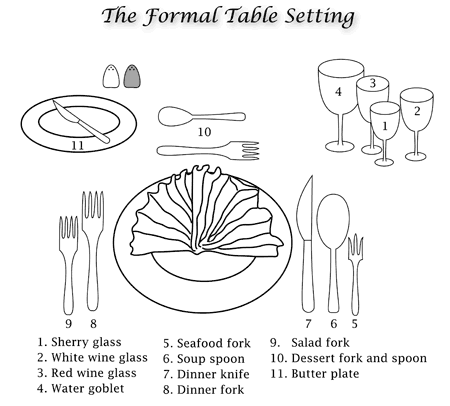Dining Etiquette
Proper etiquette is essential for making a favorable impression at both lunch/dinner interviews as well as in social business situations. Although common sense is often your best guide, the following suggestions will help you stand out as a polished professional.
Reception/Social Hour
Reception or social hours are typically for the purpose of networking for jobs and entertaining clients. Follow the lead of the majority of individuals in the room and the following basic tips:
- Keep at least one hand free. If you are standing, have only a drink or food in one hand, never both. Hold a drink in your left hand so that you have a dry hand to offer a firm, not crushing, hand shake.
- You can eat and drink while sitting, but it is always better to stand and greet.
- Make good eye contact. Don't forget to introduce yourself to the host/hostess and don't interrupt conversations.
- Avoid approaching two people engaged in deep conversation. Wait until there is a break so you can introduce yourself. Look for visual cues to join the conversation.
- Make eye contact. Ask people questions about themselves and the work they do.
- Always offer your contact information and know when it is time to go. Move on to the next group or individual, follow up with promising contacts, and assess how you can improve your performance.
Dining Etiquette
Arrival/Sitting Down
- Arrive on time and call ahead if you know you will be late.
- Do not place any bags, purses, sunglasses, cell phones, or briefcases on the table.
- Have proper posture and keep elbows off the table.
- Wait 15 minutes before calling to check on the arrival status of your dinner partners.
Table Setting
- When presented with a variety of eating utensils, remember the guideline to "start at the outside and work your way in". For example, if you have two forks, begin with the fork on the outside.
- Do not talk with your utensils and never hold a utensil in a fist.
- Set the utensils on your plate, not the table, when you are not using them.

Text-Only version of The Formal Table Setting for screen reader users
Napkin
- Typically, you want to put your napkin on your lap (folded in half with the fold towards your waist) soon after sitting down at the table, but follow your host's lead.
- The napkin should remain on your lap throughout the entire meal. Place your napkin on your chair, or to the left of your plate, if you leave the table as a signal to the server that you will be returning.
- When the host places their napkin on the table, this signifies the end of the meal. You should then place your napkin on the table as well.
Ordering and Being Served
- Do not order the most expensive item from the menu, appetizers, or dessert, unless your host encourages you to do so. While it is best not to order alcohol even if the interviewer does, alcohol, if consumed, should be in moderation.
- Avoid ordering items that are messy or difficult to eat (i.e. spaghetti, French onion soup).
- Wait for everyone to be served before beginning to eat, unless the individual who has not been served encourages you to begin eating.
During the Meal
- Eat slowly and cut only a few small bites of your meal at a time.
- Chew with your mouth closed and do not talk with food in your mouth.
- Pass food items to the right (i.e. bread, salad dressings). If you are the individual starting the passing of the bread basket, first offer some to the person on your left, then take some for yourself, then pass to the right.
- Pass salt and pepper together, one in each hand. If someone has asked you to pass these items, you should not pause to use them.
- Taste your food before seasoning it.
- Do not use excessive amounts of sweeteners - no more than two packets per meal is the rule of thumb.
- Bread should be eaten by tearing it into small pieces, buttering only a few bites at a time. Do not cut bread with a knife or eat whole.
- Gently stir your soup to cool it instead of blowing on it. Spoon your soup away from you.
- You do not have to clean your plate. It is polite to leave some food on your plate.
Be Aware of Different Eating Styles
- Continental or European Style: Cutting the food with the right hand and using the left hand to hold the food while cutting and when eating.
- American Style: Cutting the food with the right hand and holding the food with the left, then switching hands to eat with the right hand.
When You Have Finished
- When you are finished, leave your plates in the same position, do not push your plates aside or stack them.
- Lay you fork and knife diagonally across the plate, side by side, pointing at 10:00 and 4:00 on a clock face. This signifies to the wait staff that you have finished.
- The person who initiates the meal generally pays and tips appropriately (15% for moderate service, 20% for excellent service).
- Always remember to thank your host.
